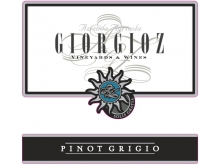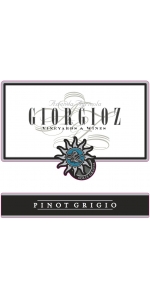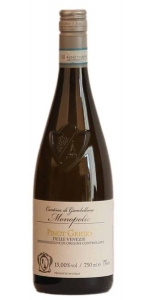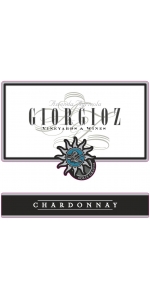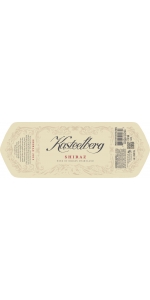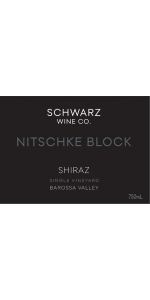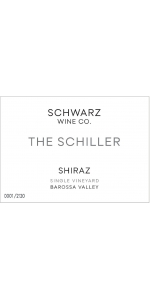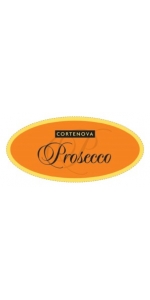Giorgio Z Pinot Grigio 2018
| Country: | Italy |
| Region: | Friuli |
| Winery: | Zaglia Giorgio |
| Grape Type: | Pinot Gris/Pinot Grigio |
| Organic: | Yes |
| Vintage: | 2018 |
| Bottle Size: | 750 ml |
Giorgio Z Pinot Grigio is made from Pinot Grigio.
D.O.C.FRIULI
Straw yellow color with golden tint.
Typical bouquet reminiscent of acacia blossom.
The wine has a very refined taste, it is dry and full bodied with pleasing bitterness.
Soil type is Clay.
Average age of the vines is 15 years old.
100% hand harvested.
Fermentation at 15°C during 15 days.
Aged in stainless steel tank on the fine lees for 6 months.
Slight filtration before bottling
Gambellara Pinot Grigio delle Venezie Monolopio is made from 100% Pinot Gris.
Color: Brilliant pale lemon colored with greenish reflections.
Bouquet: Intense bouquet full of yellow peaches, green apples and delicate white flowers.
Taste: Full, fresh and inviting with great minerality. A wine of excellent acidity and a persistent aftertaste. The overall balance of this wine reflects the care and attention dedicated to the winemaking. It is a Pinot Grigio of distinctive quality.
Seafood dishes, risottos with scampi, spaghetti with clams, sole in white wine, white meats and light cheeses.
RS: 4 grams/Liter
Acidity: 6 grams/Liter
D.O.C.FRIULI
Pale straw yellow color.
The aromas are fine and elegant with apple and acacia flowers scent and a note of bread crust.
The wine is hamonious, smooth and soft.
Soil type is Clay.
Average age of the vines is 15 years old.
100% hand harvested.
Fermentation at 15°C during 15 days.
Aged in stainless steel tank on the fine lees for 6 months.
Slight filtration before bottling
The Kasteelberg range of wines, celebrates the discovery of Riebeek and the Kasteelberg mountains in 1661. Kasteelberg stands sentinel over the fertile valley below. From the slopes of the mountains, hand-selected grapes are expertly crafted with care to produce rare and expressive wines. The Kasteelberg range truly is the pinnacle of our Winemaker's art.
Often referred to as Shiraz Country, the Riebeek Valley is renowned for exceptional Shiraz wines.
The Kasteelberg Shiraz is a lively rich wine, full bodied with a subdued smokiness on the nose and a pallet of ripe fruit and interesting spice.
Well-balanced and smooth, the aftertaste lingers with the exciting flavors of Christmas pudding.
Serve at room temperature. The perfect companion to barbequed lamb, fillet medallions and game. Lovely with Springbok stuffed with bacon, garlic and rosemary and a great match to a cheese and preserve platter.
Review:
"I'd expect to prefer the 2017 Shiraz to the 2018 bottling, but it's actually the reverse. Maybe Alecia Boshoff has just got more experience with the fruit from this Kasteelberg site. Sweet and spicy, with enticing incense and violet aromas, fine tannins, succulent red berry fruit and deftly integrated one-third new oak. 2021-26"
- Tim Atkin (South Africa 2020 Report), 92 pts
Schwarz Nitschke Block Shiraz is made from 100 percent Shiraz.
This Bethany vineyard was planted by Jason Schwarz's parents in 1968 and has been tended to by the hands of his family ever since. The vines are dry-grown and produce small crops of intensely flavored fruit.
A display of the purest blood-plum and black cherry, with cracked black peppercorn and streaky bacon over some seriously fine oak. Some subtle herbaceous qualities, nettle and thyme bring life to an otherwise immense nose. Very juicy on the palate, deeply flavorsome, long and with mouth-coating tannin for a very textured, very focused Barossa classic.
Slow cooked beef ribs, grilled meats, wild game and grilled vegetables.
Review:
"All the good stuff: dry-grown and fermented under the aegis of wild yeast; a smattering of whole-bunch seasoning (25%), French oak (20% new), conferring poise, freshness and authority. As far as Barossa shiraz goes, this is benchmark. Plush but nicely taut. A stream of boysenberry fruit and violet scents sashay to a samba of thyme, tapenade and smoked meats, nicely avoiding any sense of reduction, or clunky jam. This is smart. Very. - Ned Goodwin"
- Halliday Wine Companion (August 2020), 96 pts
Schwarz The Schiller Shiraz is made from 100 percent Shiraz.
The Schiller Shiraz is a wine rich in both flavor and history. The 400 Shiraz vines planted by Carl August Otto Schiller in 1881 are something to be treasured. Earmarked for bulldozers in 2006, a last minute reprieve would see these Ancestor vines remain in the ground. The grapes are hand-picked from the sixth generation Schiller family vineyard at Hallett Valley in the Barossa. Jason first made this wine in 2008, and since then it has been his flagship wine.
Opens quickly to luxe fruits, black plum & fruits of the forest, building in layers of toasty smoked bacon, tobacco leaf and Mediterranean herbs with nuances of spice and earthy tones. A luxurious palate of old vine fruits, savory overtones and fine slippery tannins. A long harmonious finish.
Review:
- James Suckling (September 2020), 92 pts
Giorgio Z Pinot Grigio is made from Pinot Grigio.
D.O.C.FRIULI
Straw yellow color with golden tint.
Typical bouquet reminiscent of acacia blossom.
The wine has a very refined taste, it is dry and full bodied with pleasing bitterness.
Soil type is Clay.
Average age of the vines is 15 years old.
100% hand harvested.
Fermentation at 15°C during 15 days.
Aged in stainless steel tank on the fine lees for 6 months.
Slight filtration before bottling
Cortenova Prosecco Spumante NV is 100 percent Prosecco
This Prosecco comes from the highly esteemed area of Valdobbiadene. There are two recognized quality zones for Prosecco, Conegliano and Valdobbiadene. Of the two, Valdobbiaden has always been recognized a having the superior quality due to its naturally higher acidity and its more northern location.
The vineyards lie at 350 meters above sea level. The vines are an average of 25 years old.
The grapes are soft pressed and the free run juice is placed in stainless steel. There is a brief maceration period of 4 hours. Specially selected yeast are added and fermentation is controlled at 20° C. There is no malolactic fermentation and the wine is transferred to autoclaves and a second fermentation is induced following the Charmat tradition. When the desired atmospheric pressure is reached (usually 1 month) the wine is bottled.
Light straw colored with greenish reflections. The perlage is fine and continuous. Fragrant bouquet full of flowers and almonds. In the palate it is fresh and clean with a soft body and a pleasing sparkle. The fruit is subtle and reminiscent of apples and pears with a hint of almond in the background. The finish is inviting.
Can be drunk by itself as an aperitif or with seafood and fish, pastas with cream sauces, chicken and fresh cheeses.
Review:
"Pale straw color. Bright, attractive aromas and flavors of roasted lemons and kiwis, green nectarine, nougat, and grass with a soft, vibrant, spritzy, dry-yet-fruity medium body and a tingling, complex, medium-length spiced clementine and delicate herbal honey finish with silky, crunchy, fruit tannins and no oak. A delicious, nicely layered Prosecco with an elegant style." - Beverage Testing Institute (November 23rd 2015), 91 pts, Best Buy
- back
This is a 9 liter imperial also called a Salmanazar .
Roland Champion Champagne Blanc de Blanc Grand Cru 2014 is made from 100% Grand Cru Chardonnay from the chalky soils of Chouilly.
This Champagne is full of elegance and finesse. Very complex nose, with a bouquet of aromas dominated by honey, brioche and notes of dried fruits, hazelnuts and sweets. Perfectly matured.
Manual harvest; then pressing immediately to avoid oxidation & preserve quality. Free run juice only. Aged six years on the lees.
It matches magnificently with foie gras!
Review:
"Based in Chouilly on the Côte des Blancs, it is obvious this producer will have a Blanc de Blancs Champagne. And very good it is, with some age after six years on lees while still having freshness, crisp acidity and a tight, steely edge. The bottling will benefit from further aging, and it will be at its best from 2022. - ROGER VOSS"
- Wine Enthusiast (December 2020), 92 pt
Gaja Sperss is made from 100 percent Nebbiolo.
Vibrant and intense notes of herbs and spices such as thyme, cloves and black pepper. On the palate the wine is tense, loaded with energy that will need serious ageing to fully develop although extremely approachable in its youth. Impressive fruit concentration, with dark and ripe fruits – prunes and black cherries. Acidity and tannins lift this wine to its freshest expression.
Nebbiolo based wines have not only complexity and structure but also great elegance and finesse. The distinctive silky tannins of the Nebbiolo make it the right wine to drink with meat. Usually a young vintage goes very well with richer dishes because of the stronger tannins; mature Barolos are more suitable with delicate white meat courses or braised meat courses with sauces or concentrated red wines reductions.
Review:
The 2019 Barolo Sperss is rich with dark mineral earth, black cherry, and Earl Grey tea. Long and mouthwatering, it has a powerful structure while retaining finesse. It is fantastically balanced, with gripping tannins, fresh acidity, and notes of forested earth and ripe red berries. A wine for the long haul, this is another great and noble wine to drink over the coming three decades.
-Jeb Dunnuck 99 Points

